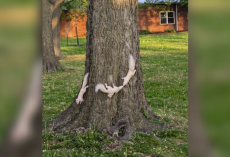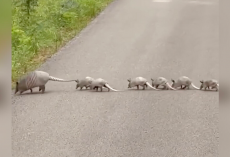It’s always incredible news when a new baby animal is born, especially when they’re a part of a critically endangered species. Each new birth is a crucial step towards ensuring their future survival.
Recently, the Saint Louis Zoo announced incredible news: three critically endangered Amur tiger cubs were born on November 13, an inspiring sign of hope for one of the most endangered big cats in the world.
According to a press release from the zoo, the cubs’ parents are 5-year-old mom Reka and 11-year-old dad Maxim. The mother and cubs are reportedly doing well, residing in a quiet, private maternity den in the zoo’s Big Cat Country habitat.

The AZA-accredited zoo, home to over 16,000 animals across 500 species, said that their Animal Care team is monitoring the tigers via camera, and say that Reka is an “attentive mom” who cleans, feeds and keeps her cubs warm. The mom and newborns will be behind the scenes during these first critical months, until they are big enough to navigate the outdoor habitat.
It marks the first birth of Amur tiger cubs at the St. Louis Zoo in over a decade, and the zoo described their arrival as a “significant contribution to the population of Amur tigers in North American zoos.” Reka and Maxim were paired on a breeding recommendation by the Association of Zoos and Aquariums Amur Tiger Species Survival Plan: they both arrived at the zoo in 2021.

The Amur tiger, also known as the Siberian tiger, is a critically endangered species, considered one of the most endangered big cat species in the world, with a population of less than 500 in the wild.
The species once lived throughout Siberia and the surrounding areas, and was thus known as the Siberian tiger, according to the zoo’s press release. But factors like habitat loss and poaching severely reduced their population and range, to the point where they are no longer found in Siberia, and now mostly reside in the Russian Far East (their new name comes from the Amur River in Russia.)
With so few Amur tigers left in the world, in-captivity breeding programs are essential in keeping this species from extinction. Other zoos have also seen recent success in breeding Amur tigers: in May, the Cheyenne Mountain Zoo, in Colorado Springs, Colorado, welcomed a pair of twins around Mother’s Day.
What amazing news — these adorable cubs are a crucial step in ensuring the survival of this majestic big cat species. Welcome to the world! ❤️
Please share this amazing news!











